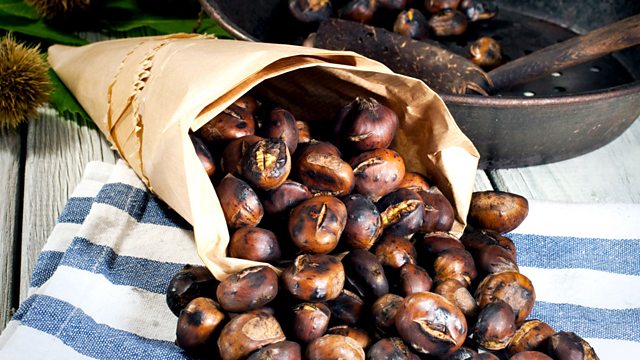21/12/2012
Celebrating, informing and entertaining women. The longest-serving NHS nurse is about to retire. Plus, cooking chestnuts at Christmas. Presented by Jenni Murray.
Chestnuts are inextricably linked to the Christmas period as this is the time of year when they are at their best. The season only runs for around three months (November - January). Chestnuts make for a great ingredient to use for stuffing or go equally well with sprouts and bacon. But what are the other ways of using them in cooking?
Jean Colclough, believed to be the longest serving nurse in the NHS, is to retire next week from the Southend University Hospital. She has spent all her working life as a nurse in that area. When she was born, the NHS didn't even exist. She is now nearly 75 and started her nurse training at the age of 18 in September 1956 earning 拢260 a year. She was 22 when she qualified in 1960. We hear about her memories as a nurse, how the NHS has changed and whether she still thinks it is the best form of health care.
Is it possible to name our power list without the advantage of hindsight? How do we know these women really are powerful - rather than a flash in the pan? Do you need an historical perspective to define who was and is powerful? Margaret Thatcher would not be on our list today, but in terms of power, her influence and legacy probably affects all of us more now than anyone who will be on the list of 2012.
Presented by Jenni Murray.
Last on
Clip
-
![]()
The legacy of power: The Power List
Duration: 10:08
Cooking with Chestnuts
Chestnuts are听inextricably linked to the Christmas period as this is the time of year when they are at their best. The season only runs for around three months (November - January). Chestnuts make听a great ingredient to use for stuffing or go equally well with sprouts and bacon.听 Jenni is joined by Michael Vanheste, a tutor at Bettys Cookery School in Harrogate to discuss the different听ways of using them in cooking?听
The Power List; The Legacy of Power
Is it possible to name the women on our Power List without the advantage of hindsight? How do we know these women really are powerful 鈥� rather than a flash in the pan? Do you need an historical perspective to define who was and is powerful? Margaret Thatcher would not be on our list today, but in terms of power, her influence and legacy probably affects all of us more today than anyone who will be on the list of 2012. Helen Castor, historian and broadcaster and听Sonja Tiernan, Lecturer in History at Liverpool Hope University join Jenni to discuss the legacy of power.
Lucy Rose
Girl Choristers
Jean Colclough; the NHS's longest serving nurse
Cooking with Chestnuts: recipes
Chestnut & Rosemary Scones
听
Makes about 8 scones (depending on cutter size)
听
Ingredients
听
75g butter
180g self raising flour
60g chestnut flour
陆 tsp salt
1 tsp baking powder
40g caster sugar
75g cooked chestnuts
1 sprig fresh rosemary
1 egg (medium) beaten
2-3 tbsp buttermilk
1 beaten egg to glaze
听
Method
听
1.听听听听 The butter should be cool but not fridge cold, therefore remove the butter from the fridge about 20 minutes before using and dice it up.听 Preheat the oven to 200掳C (fan assisted) and line a baking tray with baking parchment.
听
2.听听听听 Sift the flours, salt and baking powder in a bowl and mix together.
听
3.听听听听 Place the butter in the bowl with the flours.听 Use your fingertips to rub the butter and flour together until the mixture becomes a fine breadcrumb consistency.听 Stir the caster sugar in.
听
4.听听听听 Finely chop the cooked chestnuts.听 Remove the leaves from the rosemary sprig and chop very finely.听 Stir the chopped chestnuts and rosemary into the mixture.
听
5.听听听听 Beat the egg in a measuring jug and add 2 tbsp of the buttermilk.听 Mix together.
6.听听听听 Make a well in the centre of the dry mixture and pour in the egg and buttermilk.听 Use a cutlery knife to mix the ingredients thoroughly.听 The cutlery knife will cut through the mix without overworking it.听 Add a further tablespoon of buttermilk should the mixture seem too dry.听 Now use your hand to bring to a soft dough.
听
7.听听听听 On a lightly floured surface, roll the dough out to a thickness of about 2cm.听 Using a sharp knife cut into 8 triangles or alternatively, use a round floured scone cutter.
听
8.听听听听 Place the scones onto the baking tray lined with baking parchment, brush the top with beaten egg and bake in the preheated oven 10-12 minutes or until risen and golden.
听
Note
听
路听听听听听听听听 If you cannot find chestnut flour (try online) then it is possible to replace it with plain flour.
路听听听听听听听听 The wetter the dough, the harder it is to work with but the more delicious they will turn out to be.听 Flour your hands if you find the mixture is too sticky.
路听听听听听听听听 To ensure even rising, don鈥檛 twist the cutter and make sure the cutter is well floured.听 Ensure the egg wash does not drip down the side of the scones.听
路听听听听听听听听 Make smaller scones and serve as canap茅s!
路听听听听听听听听 As with all scones, they are best made fresh and eaten as soon as possible!
听
To serve
Split the scones and spread some duck p芒t茅 over one half.听 Spoon over some Bettys Caramelised Onion Chutney over the other half and sandwich together.听 Serve immediately.
听
听
Marrons Glac茅s
听
Ingredients
听
1 kg large, good quality chestnuts
听
For the syrup:
1 kg golden caster sugar
1 litre water
2 tbsp liquid glucose
1 vanilla pod
听
Method
听
1.听听听听 Bring a pan of water to the boil.听 Score the brown skin of the chestnuts with a sharp knife, going all the way around from the rounded end to the tufted end.听 Place them in a bowl filled with cold water and leave to soak for around 5 minutes.听
听
2.听听听听 You need to remove both the thick brown skin as well as the inner membrane.听 In batches of around 5 fruits, plunge the chestnuts into the pan of boiling water and blanch for around 3 minutes.听 The skins will start to open up and as they do, remove from the pan and peel immediately.听 You need to work quite quickly as the inner membrane doesn鈥檛 come off easily when it has cooled.听 You can use a paring knife to aid in this process, being careful not to damage the fruit.听 Refresh the chestnuts in a bowl of cold water.听 Repeat until all chestnuts have been peeled.听
听
3.听听听听 Make the syrup by placing the golden caster sugar, water and glucose into a heavy based pan and bring to the boil.听 Stir just until the sugar has dissolved.听 When the syrup comes to the boil, split the vanilla pod in half lengthways and scrape out the seeds.听 Add the vanilla seeds and pod to the pan and boil over a high heat for around five minutes.听
听
4.听听听听 Add the chestnuts to the syrup and bring the liquid back up to a simmer.听 Simmer very gently for 5 minutes.听
听
5.听听听听 Take the pan off the heat and leave to cool down completely.听 When cool, cover the pan and leave at room temperature for 24 hours.听
听
6.听听听听 The next day, remove the chestnuts from the syrup and set aside.听 Place the pan over a high heat and bring the syrup to the boil.听 Carefully return the chestnuts to the boiling syrup, turn down the heat and simmer very gently for three minutes.听 Remove the pan from the heat and set aside for 24 hours.听
听
7.听听听听 Repeat the previous step for up to six days or until the chestnuts have absorbed lots of the syrup and have become almost translucent.听 They will not resemble cooked chestnuts by this stage but should look preserved.听
听
8.听听听听 After the last 24 hour cooling/resting period, remove the chestnuts from the pan and arrange on a cooling rack set over a baking tray to catch any syrup.听 Spoon some of the syrup over each chestnut and leave to air dry, uncovered, at room temperature for a further 24 hours.听
听
9.听听听听 Should you wish to glaze the chestnuts, mix a tablespoon of syrup with a tablespoon of icing sugar.听 Use a pastry brush to glaze the chestnuts and then follow step 10.听 Store in an airtight container preferably in the vegetable tray of the refrigerator.听 Bring to room temperature before serving.听 They are best enjoyed within ten days.听
听
听Note:
听
路听听听听听听听听 It is almost inevitable that some of the chestnuts will break up.听 Carry on with the confit process as described and use the broken chestnuts to make a pur茅e to use in desserts.
路听听听听听听听听 Take care when peeling the chestnuts, they will be very hot as they come out of the water and this part is the most arduous of the task.听 Perseverance will be rewarded when you taste these delicacies at the end of the process.
听
听
听
Chestnut & Hazelnut Cake Ingredients
Makes a 20cm diameter cake
4 large eggs
280g caster sugar, divided
into 2 halves
200g chestnut pur茅e
100g plain white flour
100g ground hazelnuts
50g chopped hazelnuts
50g ground almonds
cocoa powder for dusting
听
Method
1. Preheat the oven to 175潞C (gas mark 3陆). Line the base and sides of a 20cm diameter cake tin (preferably springform or loose-bottomed) with baking parchment, using a little melted butter to keep it in place.
听
2. Separate the eggs, putting the whites to one side. Put the yolks and one half of the caster sugar in a large mixing bowl. Whisk together until pale and creamy and doubled in volume. Mix in the chestnut pur茅e, then fold in the flour, sifting it through a sieve. Finally, gently stir in the ground and chopped hazelnuts followed by the ground almonds.
听
3. Place the egg whites in a clean bowl and whisk thoroughly until they form soft peaks. Add the remaining sugar and continue to beat until thick and glossy. With a large metal spoon, stir a little of the egg-white mixture into the nut mixture to slacken it, then gently fold in theremainder of the egg-white mixture. 4. Spoon into the prepared cake tin and place in the preheated
oven for approximately 50 - 55 minutes until firm to the touch and golden brown. To test, pierce with a clean skewer 鈥� if it comes out clean, the cake is ready. Allow to cool completely before sprinkling with cocoa powder. Delicious with a dollop of whipped cream or cr猫me fra卯che.
听
听
听
Broadcast
- Fri 21 Dec 2012 10:00麻豆官网首页入口 Radio 4
Follow us on Instagram
Get all the pictures, videos, behind the scenes and more from Woman鈥檚 Hour
Podcast
-
![]()
Woman's Hour
Women's voices and women's lives - topical conversations to inform, challenge and inspire.



